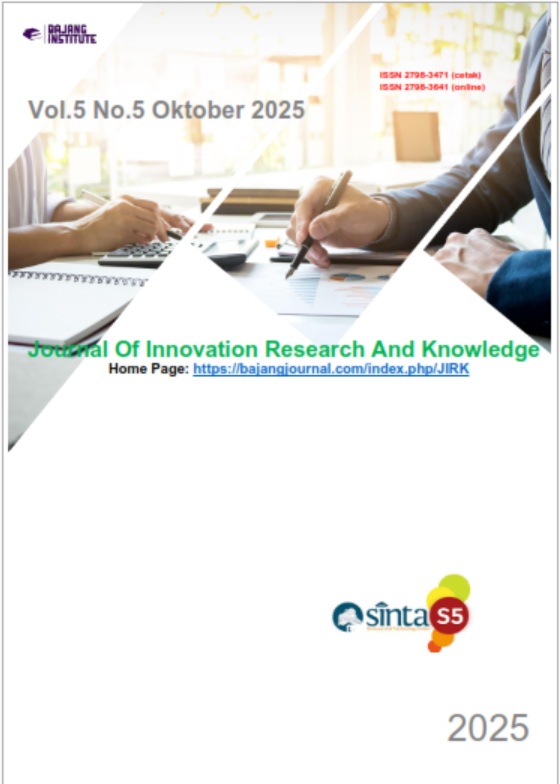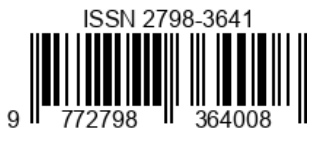STUDENTS’S PERCEPTIONS IN USING GRAMMARLY AND QUILLBOT FOR IMPROVE WRITING SKIIL AT MA ANNUR TELUK PALINGET GRADUATE STUDENTS OF PALANGKARAYA UNIVERSITY
Keywords:
Students’ Perceptions, QuillBot, Grammar AssistanceAbstract
By using a descriptive quantitative design, data were collected through a cross-sectional survey. The population included 95 students from grades 10 to 12 who regularly used both tools for English writing. After a pilot test with 30 students, 65 students were selected as the final sample. Data were gathered using a validated questionnaire via Google Forms, covering four dimensions: tool features, Grammarly and QuillBot are al-power tool that help users identity and correct grammar, vocabulary, and sentence structure errors. All these tools become more common in Education, understanding students’ perception of their effectiveness is essential for optimizing their use in EFL writing instruction. This research explores students’ perceptions of Grammarly and quillBot for writing development at Ma Annur Teluk Palinget in the year of 2025 by focusing on Grammar improvement and the factors shaping those perception.feedback quality, knowledge and ability development, and learning experience. Analysis used frequency, percentage, and mean scores in Microsoft Excel. Validity (Pearson > 0.349) and reliability (Cronbach's Alpha = 0.967) were confirmed through pilot testing. The results indicate that students at MA Annur Teluk Palinget held very positive perceptions of both Grammarly and QuillBot, with identical overall mean scores of 3.85. All dimensions—features, feedback quality, knowledge development, and learning experience—were rated very positively, with over 80% strongly agreeing that the tools provided helpful grammar feedback, clear suggestions, and useful explanations. Students particularly noted improvements in understanding subject-verb agreement (89%), sentence structure (85%), and tense consistency (80%), along with increased confidence and motivation. These perceptions were primarily shaped by three factors: accessibility (mean: 3.91), educational effectiveness (3.84), and user experience (3.83), which explained 77% of the total variance. While a small number of students raised concerns—such as language barriers, internet dependence, and feedback accuracy for complex grammar—both tools significantly supported grammar improvement and were seen as suitable for integration into high school EFL instruction
References
Carvalho, J., Pereira, L., & Laranjeira, R. (2018). Writing a master’s dissertation – students’ perspectives. Journal of Academic Writing, 8(2), 78-88. https://doi.org/10.18552/joaw.v8i2.481
Cohen, L., Manion, L., & Morrison, K. (2011). Research methods in education (7th ed.). London: Routledge.
Cornelius, T., Willey, J., Edmondson, D., Elkind, M., & Kronish, I. (2020). Are patients afraid to go home? Disposition preferences after transient ischaemic attack and minor stroke. Emergency Medicine Journal, 37(8), 486-488. https://doi.org/10.1136/emermed-2019-209154
Creswell, J. W. (2014). Research design: Qualitative, quantitative and mixed methods approaches (4th ed.). Thousand Oaks, CA: Sage.
Dewi, U. (2023). Grammarly as automated writing evaluation: Its effectiveness from EFL students’ perceptions. Lingua Cultura, 16(2), 155-161. https://doi.org/10.21512/lc.v16i2.8315
Dizon, G. (2023). Exploring the effects of Grammarly on EFL students’ foreign language anxiety and learner autonomy. The JALT Call Journal, 19(3), 299-316. https://doi.org/10.29140/jaltcall.v19n3.1049
Dizon, G., & Gayed, J. (2021). Examining the impact of Grammarly on the quality of mobile L2 writing. The JALT Call Journal, 17(2), 74-92. https://doi.org/10.29140/jaltcall.v17n2.336
Dörnyei, Z., & Taguchi, T. (2010). Questionnaires in second language research: Construction, administration, and processing (2nd ed.). Routledge.
Dwifadjrin, G., & Pamungkas, M. (2020). The use of video as media in teaching writing descriptive text. Project (Professional Journal of English Education), 3(5), 624. https://doi.org/10.22460/project.v3i5.p624-632
Embogama, S. (2023). Exploring the efficacy of utilizing song texts as an instructional tool for teaching the present perfect tenses. SLJO-J-JRM, 1(2), 26-34. https://doi.org/10.4038/jrm.v1i2.9
Fahmi, M., & Cahyono, B. (2021). EFL students’ perception on the use of Grammarly and teacher feedback. JEES (Journal of English Educators Society), 6(1), 18-25. https://doi.org/10.21070/jees.v6i1.849
Fahmi, S., & Rachmijati, C. (2021). Improving students’ writing skill using Grammarly application for second grade in senior high school. Project (Professional Journal of English Education), 4(1), 69. https://doi.org/10.22460/project.v4i1.p69-74
Fernando, E., & Suryaman, M. (2022). Appropriating grammar as a tool in writing activities: Student's perception. Journal of English Language and Education, 7(2), 1-8. https://doi.org/10.31004/jele.v7i2.232
Fish, L. (2017). A study of changes in online graduate business student perceptions over a course. The BRC Academy Journal of Education, 6(1), 15-39. https://doi.org/10.15239/j.brcacadje.2017.06.01.ja01
Fitria, R., Sabarun, S., & Miftāḥ, M. (2022). Students’ perception of the use of Grammarly in undergraduate thesis writing. Project (Professional Journal of English Education), 5(2), 366. https://doi.org/10.22460/project.v5i2.p366-371
Fowler, F. J. (2014). Survey research methods (5th ed.). Centre for Survey Research, University of Massachusetts.
Graham, S. (2019). Changing how writing is taught. Review of Research in Education, 43(1), 277–303. https://doi.org/10.3102/0091732x18821125
Gürleyik, S., & Akdemir, E. (2018). Guiding curriculum development: student perceptions for the second language learning in technology-enhanced learning environments. Journal of Education and Training Studies, 6(4), 131. https://doi.org/10.11114/jets.v6i4.2994
Hadiat, A. W. F. (2022). The use of Grammarly to enhance students' accuracy in writing descriptive text. Journal of English Education Program (JEEP), 9(2), 133-138. http://dx.doi.org/10.25157/(jeep).v9i2.8552
Haerazi, H., Utama, I., & Hidayatullah, H. (2020). Mobile applications to improve English writing skills viewed from critical thinking ability for pre-service teachers. International Journal of Interactive Mobile Technologies (IJIM), 14(07), 58. https://doi.org/10.3991/ijim.v14i07.11900
Hakiki, G. (2021). Perception of EFL students on the use of Grammarly application in writing class. Eduvelop (Journal of English Education and Development), 4(2), 99-106. https://doi.org/10.31605/eduvelop.v4i2.891
Humphrey, S., & Macnaught, L. (2015). Functional language instruction and the writing growth of English language learners in the middle years. TESOL Quarterly, 50(4), 792–816. https://doi.org/10.1002/tesq.247
Iersel, M., Latour, C., Vos, R., Kirschner, P., & Reimer, W. (2018). Perceptions of community care and placement preferences in first-year nursing students: A multicenter, cross-sectional study. Nurse Education Today, 60, 92-97. https://doi.org/10.1016/j.nedt.2017.09.016
Jansen, H. (2010). The Logic of Qualitative Survey Research and Its Position in the Field of Social Research Methods. Forum Qualitative Sozialforschung, 11. http://www.qualitative-research.net/index.php/fqs/article/view/1450/2946
Jones, C., & Fortescue, S. (1987). Using computers in the language classroom.
Kassem, M. (2017). Developing business writing skills and reducing writing anxiety of EFL learners through wikis. English Language Teaching, 10(3), 151–164. https://doi.org/10.5539/elt.v10n3p151
Khalil, Z. (2018). EFL students’ perceptions towards using Google Docs and Google Classroom as online collaborative tools in learning grammar. Applied Linguistics Research Journal. https://doi.org/10.14744/alrj.2018.47955
Kiersma, M., Plake, K., Newton, G., & Mason, H. (2010). Factors affecting prepharmacy students' perceptions of the professional role of pharmacists. American Journal of Pharmaceutical Education, 74(9), 161. https://doi.org/10.5688/aj7409161
Kurniati, E., & Fithriani, R. (2022). Post-graduate students’ perceptions of QuillBot utilization in English academic writing class. Journal of English Language Teaching and Linguistics, 7(3), 437. https://doi.org/10.21462/jeltl.v7i3.852
Latifah, S. (2024). The use of QuillBot in academic writing. Journey (Journal of English Language and Pedagogy), 7(1), 110-121. https://doi.org/10.33503/journey.v7i1.4047
Lee, Y. (2024). University students’ perceptions of artificial intelligence-based tools for English writing courses. Online Journal of Communication and Media Technologies, 14(1), e202412. https://doi.org/10.30935/ojcmt/14195
Luwoye, A. (2023). Science teachers’ perceptions of factors influencing senior school students’ performance in steam. Jurnal Pendidikan Multimedia (Edsence), 5(2), 15-26. https://doi.org/10.17509/edsence.v5i2.60767
Maharani, M., & Sholikhatun, E. (2022). Punctuation and capitalization in writing: How do students produce them? Journal of Advanced Multidisciplinary Research, 3(1), 53. https://doi.org/10.30659/jamr.3.1.53-61
Maijo, S. N. (2021). Learners’ perception and preference of open and distance learning mode at the Institute of Adult Education, Tanzania. East African Journal of Education and Social Sciences, 2(Issue 3), 79-86. https://doi.org/10.46606/eajess2021v02i03.0106
Mdodana-Zide, L. (2023). An interventive collaborative scaffolded approach with a writing center on ESL students’ academic writing. Journal of Culture and Values in Education, 6(2), 34-50. https://doi.org/10.46303/jcve.2023.7
Mumtaz, S. (2021). Academic writing challenges of foreign language learners in Pakistan. Journal of Arts & Social Sciences, 8(2), 97-103. https://doi.org/10.46662/jass.v8i2.181
Murtiningsih, S., Kurniawati, S., & Putri, A. (2022). University EFL students’ grammar mastery and their writing ability: A quantitative study. Advances in Social Science, Education and Humanities Research, 656, 226–236. https://doi.org/10.2991/978-2-494069-65-7_21
Narvika, I., Supriyadi, D., & Deviyanti, R. (2021). The correlation between students’ grammar mastery and writing ability in descriptive text of the first grade students in MAN 1 Bandar Lampung. U-Jet Unila Journal of English Language Teaching, 10(3). https://doi.org/10.23960/ujet.v10.i3.202112
Nova, M. (2018). Utilizing Grammarly in evaluating academic writing: A narrative research on EFL students’ experience. Premise Journal of English Education, 7(1), 80. https://doi.org/10.24127/pj.v7i1.1300
Nurhasanah, N., & Huriyah, S. (2019). Enhancing students’ writing achievement through e-mail exchanges on personal letters. Eternal (English Teaching Journal), 10(2), 78–89. https://doi.org/10.26877/eternal.v10i2.5123
Nurhidayah, A. (2024). Grammarly through the lens of student perception. Jurnal Bahasa Sastra Dan Studi Amerika, 30(1), 11. https://doi.org/10.20961/jbssa.v30i1.87858
Olga, S. (2019). Teaching business English with TED Talks: Putting ideas into practice. Journal of Language and Education, 5(2), 95-111. https://doi.org/10.17323/jle.2019.7995
Oluwatayo, A., Aderonmu, P., & Aduwo, E. (2015). Architecture students’ perceptions of their learning environment and their academic performance. Learning Environments Research, 18(1), 129–142. https://doi.org/10.1007/s10984-015-9172-7
Opoku-Darko, J. (2023). Ghanaian students’ perceptions of Chinese language learning. American Journal of Education and Practice, 7(1), 26-34. https://doi.org/10.47672/ajep.1329
Park, M., & Chitiyo, M. (2010). An examination of teacher attitudes towards children with autism. Journal of Research in Special Educational Needs, 11(1), 70–78. https://doi.org/10.1111/j.1471-3802.2010.01181.x
Parra G, L., & Calero S, X. (2019). Automated writing evaluation tools in the improvement of the writing skill. International Journal of Instruction, 12(2), 209-226. https://doi.org/10.29333/iji.2019.12214a
Paudel, J. (2022). Demystifying writing: Strategies for developing better writing. Journal of NELTA, 27(1-2), 181-200. https://doi.org/10.3126/nelta.v27i1-2.53202
Pawlak, M. (2018). Grammar learning strategy inventory (GLSI): Another look. Studies in Second Language Learning and Teaching, 8(2), 351-379. https://doi.org/10.14746/ssllt.2018.8.2.8
Pitenoee, M., Modaberi, A., & Ardestani, E. (2017). The effect of cognitive and metacognitive writing strategies on content of the Iranian intermediate EFL learners’ writing. Journal of Language Teaching and Research, 8(3), 594. https://doi.org/10.17507/jltr.0803.19
Polat, E. (2023). Are existing mobile writing applications for writing difficulties sufficient?. Participatory Educational Research, 10(5), 19-40. https://doi.org/10.17275/per.23.73.10.5
Pramasta, R. G., & Wibowo, Y. W. A. (2023). Virtual reality and language learning in hospitality: an investigation of students' perceptions. International Journal of Current Science Research and Review, 06(08). https://doi.org/10.47191/ijcsrr/v6-i8-32
Puri, G. (2023). The use of Grammarly by tertiary English language learners in their online writing classes. English Education Journal of English Teaching and Research, 8(2), 163-179. https://doi.org/10.29407/jetar.v8i2.20981















